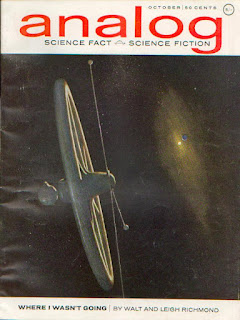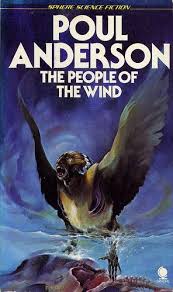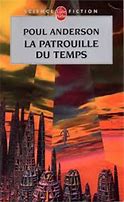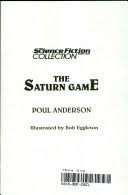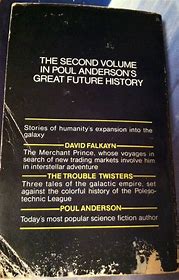Monday, 31 January 2022
Hloch's Audience
Sol City
"The Star Plunderer" features Manuel Argos who will found the Terran Empire. In Dominic Flandry's time, the Imperial capital will be Archopolis, Terra. Donvar Ayeghen, author of the Introduction to "The Star Plunderer," tells us that the story is Chapter V of the Memoirs of Rear Admiral John Henry Reeves, Imperial Solar Navy, and that this book, written in the early period of the First Empire, was excavated from the ruins of Sol City, Terra.
We deduce that:
Fictional Introductions
Companion Volumes In A Unique Way
The People Of The Wind, a novel, and The Earth Book Of Stormgate, a collection, are companion volumes in a unique way. The People Of The Wind is set mostly on the planet Avalon whereas the Earth Book is fictitiously published there. A character in the former is an author of the latter. In the novel, Governor Saracoglu summarizes events that had led to the colonization of Avalon and the Earth Book collects narratives about some of those events. Some of these accounts were previously published on Avalon or elsewhere as works of fiction although based on real events. Thus, authors put fictional conversations into the mouths of real people. Hloch, the editor of the Earth Book, wants to record the events that had led to the founding of his own choth, Stormgate, so he does not include any out and out fiction whereas, in The Technic Civilization Saga, the last Earth Book installment is followed by "The Star Plunderer," which might be historical fiction, and by "Sargasso of Lost Starships," which almost certainly is. The Technic History definitely includes different kinds of narratives. It opens with:
What The Previous Post Left Out
No post is ever comprehensive enough to do full justice to its subject matter. In the Earth Book, as discussed in the previous post (see the above link), the four Ythrian short stories and the new introductions between them cover:
the exploration of the planet Ythri and a discovery about Ythrian physiology;
the exploration of the planet Gray/Avalon, the nature of the Ythrian New Faith with some information about the Old Faith and a first mention of the planet Aeneas;
human and Ythrian colonization of the Hesperian Islands on Avalon;
joint colonization of the Coronan continent on Avalon;
the aftermath of the Terran War on Avalon that is described in The People Of The Wind.
In that novel, Ekrem Saracoglu, Imperial Governor of Sector Pacis, summarizes the relevant history:
500 years ago, the same Grand Survey ship discovered Ythri and Gray;
Gray, not renamed Avalon until much later, was colonizeable, but too far from Terra;
Ythri, forty light-years further away, began to trade with Technic civilization;
350 years ago, 50 years before the collapse of the Polesotechnic League, a human company led by an old trade pioneer proposed colonization of Avalon under Ythrian protection;
Ythrians agreed and some joined the colony;
the Troubles led to the formation of the Terran Empire and the Domain of Ythri;
the Avalonians, as they now were, became united in adversity.
Although Saracoglu does not know it yet, the Avalonians are determined to remain in the Domain despite his attempt to "rectify" the border.
The Best Future History Collection
The Earth Book Of Stormgate:
collects 12 of the 43 installments of Poul Anderson's History of Technic Civilization;
adds 12 introductions and 1 afterword ingeniously derived from the background details of the Ythrian novel, The People Of The Wind;
overlaps by 7 installments with the 11 collected in The Technic Civilization Saga, Volume I, The Van Rijn Method;
both begins and ends with two Ythrian short stories;
completes the Polesotechnic League series in the intervening eight installments;
mentions Ythri in the third installment and places Nicholas van Rijn in an Ythrian spaceship in the tenth installment;
includes both the first short story and the first novel about Nicholas van Rijn;
introduces Adzel;
discloses important information about David Falkayn's dealings with both Merseia and Mirkheim;
even follows up on Ivanhoe, the first planet where we saw Falkayn in action.
I have said it all before but I can never get enough of the Earth Book. No other future history series that I know of has anything like it.
Three Just Men
Sunday, 30 January 2022
Introducing The Terran Empire
I think that the most accurate summary of Poul Anderson's The Earth Book Of Stormgate is one that I formulated a while back, namely that the Earth Book completes the story of the Polesotechnic League and almost completes the story of human-Ythrian interactions. By implication, this summary informs us first that there has already been information about the League (in fact, four volumes), secondly that there has already been information about human beings and Ythrians (one novel) and thirdly that there will be more about the latter. This is true as far as it goes but what it leaves out is that, if we read the Technic History in this order, with the Earth Book as Volume VI, then that novel, The People Of The Wind, introduces not only human beings and Ythrians sharing the planet Avalon but also the Terran Empire which tries to annex Avalon and, of course, most of the post-Earth Book Technic History, nine of ten volumes, is about the Empire.
In The People Of The Wind, Tabitha Falkayn tells us that:
Changing Perspectives
Poul Anderson, The Earth Book Of Stormgate (New York, 1979), p. 434.
However, when the Technic History is collected in the seven-volume The Technic Civilization Saga, this afterword appears at the mid-point of Volume III, Rise Of The Terran Empire, even thought the Earth Book is written after the events of The People Of The Wind which appears at the end of Volume III. It follows that:
Hloch also writes after the events of "The Star Plunderer" and "Sargasso of Lost Starships," both of which appear between his afterword and The People Of The Wind;
Hloch writes during the Terran Empire period although before the lifetime of Dominic Flandry.
"The Star Plunderer," in which Mauel Argos proclaims the Terran Empire, is introduced not by Hloch of Stormgate Choth but by Donvar Ayeghen of the Galactic Archaeological Society who lives not only after Hloch but so long after the Terran Empire that he refers to it as the First Empire even though we have no information about any subsequent Empires.
I hope that I have conveyed what I meant by changing perspectives.
(I am currently unable to send emails but that this will be resolved by tomorrow.)
(It is resolved.)
The Polesotechnic League In Its Glory
Creating Universes
Keith Denison of the Time Patrol, when captured in ancient Persia, kicks his timecycle into time-drive:
From GENESIS To GENESIS
There are other long sequences.
To mould me Man? did I solicit thee
From darkness to promote me...?
Saturday, 29 January 2022
A Literary Odyssey
European literature begins with Homer's Iliad and Odyysey.
Virgil followed and imitated Homer's epics with his Aeneid.
Somewhere I read a comparison of the Time Traveler's itinerary in 802,701 A.D. with the Odyysey. (This is the weak link because I can't remember where I read it.)
James Joyce wrote Ulysses.
Stanley G. Weinbaum wrote "A Martian Odyssey."
Arthur C. Clarke wrote 2001: A Space Odyssey.
Poul Anderson's Dominic Flandry refers to "...blooded horses stamp[ing] on the ringing plains of Ilion..."
Sometimes it feel as if literature and fiction are one long series or at least sequence.
Where To Start?
Poul Anderson's Technic History begins off Earth. We see explorers on Iapetus, on Ythri and on Gray/Avalon before seeing Nicholas van Rijn, James Ching and Adzel on Earth in the Solar Commonwealth period. FTL interstellar travel has begun in the second story. Ironically, it is Hloch of Stormgate Choth on Avalon who informs us of the establishment of the Solar Commonwealth in his introduction to the third story.
Anderson follows and transcends Heinlein.
Between Future and Technic Histories, Anderson's Psychotechnic History begins on Earth in the aftermath of World War III, differing little as yet from the aftermath of WWII. Space travel and post-nuclear war used to be the two kinds of sf story.
Connections
two of the eleven installments are about Ythrians;
three are about Nicholas van Rijn;
another installment, "Esau," is about a one-off character, Emil Dalmady, but shows Dalmady in conversation with his employer, van Rijn;
two are about David Falkayn;
the first Falkayn story, "The Three-Cornered Wheel," is set on the planet, Ivanhoe, which is also the setting of "The Season of Forgiveness";
in the second Falkayn story, "A Sun Invisible," Falkayn has started to work for van Rijn's company, Solar Spice & Liquors;
the first Ythrian story, "Wings of Victory," mentions Hermes, Falkayn's home planet, and also Woden, home planet of Adzel who appears in "How To Be Ethnic In One Easy Lesson."
Thus, directly or indirectly, ten of the eleven installments are interconnected. There are even more connections with later volumes of The Technic Civilization Saga but here we are focusing only on Volume I.
Jim Ching reflects wistfully:
The Richest Volume In The Technic Civilization Saga?
First, it collects eleven installments of the Technic History, more than any other. The others are:
Parallels Between The Psychotechnic And Technic Future Histories
(ii) In the Psychotechnic History, hyperdrive is invented in 2784 whereas, in the Technic History, it is discovered in the twenty-second century although these are different kinds of hyperdrive.
(iii) In the Psychotechnic History, the Second Dark Ages begin in 2300 and the Third in 3200 whereas, in the Technic History, the Time of Troubles is in the twenty-seventh century and the Long Night is in the mid-fourth millennium.
(iv) In the Psychotechnic History, the Second Dark Ages and the invention of hyperdrive separate the Solar Union from the Stellar Union, the latter founded in 2900, whereas, in the Technic History, the Troubles separate the Solar Commonwealth from the Terran Empire, the latter proclaimed about 2700.
(v) In the Psychotechnic History, the Third Dark Ages are followed by human evacuation of the galactic periphery and migration to the galactic center whereas, in the Technic History, the Long Night is followed by the dispersal of human civilizations through several spiral arms.
(vi) Both histories have a chronology compiled by Sandra Miesel.
Two Realizations On Iapetus
Scobie and Broberg realize that, to escape from the game, they must kill their personae, thus permanently ending their participation in this or indeed any other psychodrama. The reader wonders whether the characters have simultaneously killed themselves in reality but, after a double paragraph space, we learn that they have not:
Which Reality?
Fantasy And Reality II
Whatever the three game players discover on Iapetus is interpreted in terms of their shared fantasy.
A large crater is:
"'...the Elf King's Dance Hall, which the Lord of the Dance built for him -'" (III, p. 33)
A glacier caused by a cometary impact is:
"'...the City of Ice, made with starstones out of that which a god called down from heaven...'" (II, p. 22)
A cliff too steep to climb is "...the fortress wall." (III, p. 33)
A gouge plowed by a meteorite was caused:
"...in the war between the gods and the magicians, when stones chanted down from the sky wrought havoc so accursed that none dared afterward rebuild." (ibid.)
Scobie remembers nothing of scientific significance since starting to climb the glacier which now shudders, cracks and dumps the explorers into the crater - the Elf King's Dance Hall - under an avalanche.
Friday, 28 January 2022
Poul Anderson's Many Achievements
Poul Anderson not only wrote more future histories than any other author but also created two ways to unify all future histories written by himself and others. They could be either alternative timelines accessible from the inter-universal inn, the Old Phoenix, or divergent timelines investigated and deleted by the Time Patrol. Holmes and Watson show up both in the Old Phoenix and in a Time Patrol case.
Furthermore, multiple future histories, the Old Phoenix sequence and the unique Time Patrol series do not exhaust Anderson's achievements which also include heroic fantasy, historical fantasy, historical fiction, detective fiction, hard sf, poetry, non-fiction and time travel fiction with the alternative premise of an immutable timeline. That might be a complete list but I am not sure.
Fantasy And Reality
Characters from fictional works of different genres can meet in Poul Anderson's Old Phoenix - as long as they don't meet anywhere else.
In a biographical film about CS Lewis, it would be easy to alternate scenes of real life and of Narnia provided that it was understood that Narnia remained imagination/fiction. However, in Shadowlands, a child looks into a wardrobe - and it is only a wardrobe.
In "The Saturn Game," explorers who have just landed on Iapetus behold a glacier:
Dates In Future Histories
The Chronology for Poul Anderson's Psychotechnic History has the Planetary Engineering Corps founded in 2055.
Isaac Asimov's Susan Calvin, born in 1982, retires at age seventy-five and dies aged eighty-two and Stephen Byerley completes his second term as World Co-ordinator in 2052.
Despite the title of its Volume III, Revolt In 2100, Robert Heinlein's Future History has the Second American Revolution occurring before 2075. Volumes I and II of the Future History cover the period 1951-2000.
However, the ends of these future histories remain a long way in the future and some other future histories go even further: Olaf Stapledon's Last And First Men and Star Maker and Anderson's Genesis.
Longevity And The Unexpected
Jean Broberg:
"At her age of forty-two, despite longevity treatment, the reddish-brown hair that fell to her shoulders was becoming streaked with white, and lines were engraved around large grey eyes." (p. 4)
Mark Danzig:
"At sixty, thanks to his habits as well as to longevity, he kept springiness in a lank frame..." (ibid.)
There will be antisenescence later in the Technic History. We note that longevity treatment has already begun in this opening installment. Minamoto's report which introduces the story is published in 2057. Thus, Broberg was born sometime before 2015 and Danzig sometime before 1997.
Garcilasco defends the role playing on the grounds that they will not land on Iapetus for a while and the ship is on automatic till then but Danzig reminds him that they must always be on watch for the unexpected. This consistent theme of every story of space exploration written by Poul Anderson links the opening and closing installments of the Technic History, "The Saturn Game" and "Starfog."
Planets And People
Thursday, 27 January 2022
Strange Punctuation
After the first introductory Minamoto extract, we read a curiously punctuated dialogue that makes sense as we read on:
"'The City of Ice is now on my horizon,' Kendrick says. Its towers gleam white." (p. 2)
This first paragraph continues in this wise with Kendrick's words in inverted commas but the descriptions of him and his surroundings in italics. The words are spoken aloud by Colin Scobie who role-plays Kendrick as a small spacecraft transports him and his three companions from the solar sail ship, the Chronos, to the Saturnian moon, Iapetus.
The second paragraph begins:
"'Yes, I see the griffin,' Ricia tells him..." (ibid.)
Jean Broberg role plays Ricia, Kendrick's lover.
Third paragraph:
"'Hold there,' warns Alvarlan from his cave of arcana ten thousand leagues away." (ibid.)
Luis Garcilaso, sitting beside the others, role plays Alvarlan.
Kendrick - Sir Kendrick of the Isles - replies in the fourth paragraph, saying that he will:
"'...spy out city and castle.'" (ibid.)
Fifth paragraph:
In The CHRONOS
In the second flashback, Kendrick and Ricia, the characters played by Scobie and Jean Broberg, become lovers although nothing like that happens between Scobie and Broberg. Does this sound as if it might become difficult?
Also relevant:
Troubles In The Polesotechnic League III
Garver's Accusations
Polesotechnic League merchants:
Troubles In The Polesotechnic League II
Troubles In The Polesotechnic League
When do internal problems of the Polesotechnic League become evident?
Wednesday, 26 January 2022
A Personal Connection
Scobie's apartment in the Chronos also contains:
Dissenting View
To understand why Minamoto presents a dissenting view, we need to reread the extracts from his minority report to see what he argues against. He says:
there should be no accusations;
no one was negligent or foolish;
the people in question struggled admirably against disaster when they understand their situation;
perhaps no saner response was possible for them;
psychodrama should not be condemned;
adult psychodrama has become so unpopular that it might become extinct which would be a worse tragedy;
psychodrama has been entirely beneficial on Earth and in space;
the modern lack of experience of madness was the root of the problem;
no one blames explorers for miscalculations about the environment - the implication being that there should also be no blame for psychological miscalculations.
We may infer that the majority report says everything that Minamoto disagrees with.
The Chaos
there is more in his head than he will put in print;
humanity muddles through its present crises;
a more humane order emerges;
English becomes Anglic and the main international language;
there is no dark age;
the transition might involve either conversion tyrannies or scientific technology (the latter is what we see in "The Saturn Game");
the more humane order becomes Technic civilization.
Anderson then discusses Satan's World, "Lodestar" and Mirkheim as showing how people later "blew it." Thus, he moves away from discussing the immediate pre-Technic period. Sandra Miesel's Chronology tells us that:
Pre-Technic History II
The Minamoto extract at the beginning of this section reaches further back in time, then forward again.
Children in pre-electronic North America played house, cops and robbers or cowboys and Indians.
In Minamoto's time, mid-twenty-first century, they play dolphins or astronauts and aliens.
Role play continues in lodges, rituals and maybe society in general.
Mid-twentieth-century entertainment was dominated by television.
Adult psychodrama became a therapeutic technique, a retreat from an unhappy period and a revolt against passive entertainment.
The Chaos ended war and fantasy games.
In the 2050s, databanks and computers generate psychodramatic scenes and sounds that enhance the vivid imaginations of the players.
Psychotherapy has become a branch of applied biochemistry so that psychodrama has ceased to have any medical use. (This part of the Technic History parallels part of Larry Niven's Known Space History.)
Less familiar than their predecessors with the human unconscious, psychologists expected only benign consequences from psychodrama in the Chronos.
Pre-Technic History
Tuesday, 25 January 2022
Various Details
Francis L. Minamoto
Page 1 of Volume I of The Technic Civilization Saga consists entirely of a single-paragraph extract from Minamoto's Death Under Saturn: A Dissenting View, published by Apollo University Communications in 2057.
Under Saturn? Under the Saturnian surface? No. It will turn out that this means on a Saturnian moon with Saturn in the sky but we do not know any of that while still reading p. 1. This page informs us only that the Chronos, presumably a spaceship bound for Saturn, has encountered some kind of tragedy, described mysteriously:
Historical Sources
the narratives of the forty-three installments of the Technic History;
the diverse introductions to some of these installments;
short expository passages within some installments;
some information given in Poul Anderson's article, "Concerning Future Histories," in the SFWA Bulletin, Fall 1979;
Sandra Miesel's Chronology of Technic Civilization, since Miesel consulted Anderson about her time chart;
anything else?
I do not list Poul Anderson's unpublished notebooks because these are, in the nature of the case, inaccessible to us.
I will maybe troll through introductions, expositions etc for any fresh details or insights.
The Polesotechnic League And Social Revolution
Nicholas van Rijn gives a Borthudian hijacker the opportunity to:
An Enforced Holiday
Falkayn, captured, becomes a house guest in Schloss Graustein, gaunt, dreary, on a high ridge, surrounded by forests with excellent hunting, with heavy but edible food, long conversations and occasional planetary guided tours in the company of his host, Landholder Graustein. Time hangs but Falkayn knows that, unbeknownst to his captors, the League is working on the problem and that he will be rescued.
He must persuade one of his captors that adjustment to League mercantilism will not be bad:
"'...even a knight must eat...'" (p. 314)
That is the entire basis of materialist philosophy. Mankind must eat, drink, have shelter and clothing, before it can pursue politics, art, science or religion. Therefore, material production and economic development underlie and explain states, laws, art and religion, not vice versa. A Yellow Emperor did not initiate agriculture. Instead, agriculture generated the material surplus that eventually supported Emperors.
Falkayn continues:
"'...and our bread doesn't come from slaves or serfs or anyone who had to be killed.'" (ibid.)
Social progress occurs and can continue.
Finally, because the captor whom he is addressing is female, Falkayn invokes the romance of mercantilism:
"'Thy merchants chase the morning down the sea...'" (ibid.)






